A Soft Landings Planting Beneath a Keystone Tree
Connecting Habitat Neighbor-to-Neighbor
by Vicki Bonk
Part 1- February 2023 Part 2- March 2023 Part 3-April 2023 Part 4-May 2023 Part 5-October 2023
Part 1- February 2023
Now, is a very good time to consider spring planting plans. First, you can momentarily transport yourself to the spring greening and warming of the landscape. Secondly, you can get ready to make the most of the growing season soon to arrive.
We all begin our gardening plans at different places. I’ll relay our small, urban home plans to enhance our native plantings. We began growing native habitat in the late 90s. This year we’ve decided to do another Soft Landings Project, like the one pictured. For a wealth of valuable information about this inspirational vision of two Minnesota locals, working alongside Douglas Tallamy*, please visit https://www.pollinatorsnativeplants.com/softlandings.html. Succinctly, the idea is to plant native species beneath keystone trees (those that support a significant number of butterfly and moth larvae), in order to allow these insects the opportunity to complete their life cycle. This shady planting also attracts and helps sustain a diversity of native pollinators, beneficial insects, and birds, throughout the year.
Here is our Northside Soft Landings Project site in May and September. The plantings are under a Pin Oak and an Autumn Blaze Serviceberry (cultivar). Plants were chosen to offer blooms throughout the season.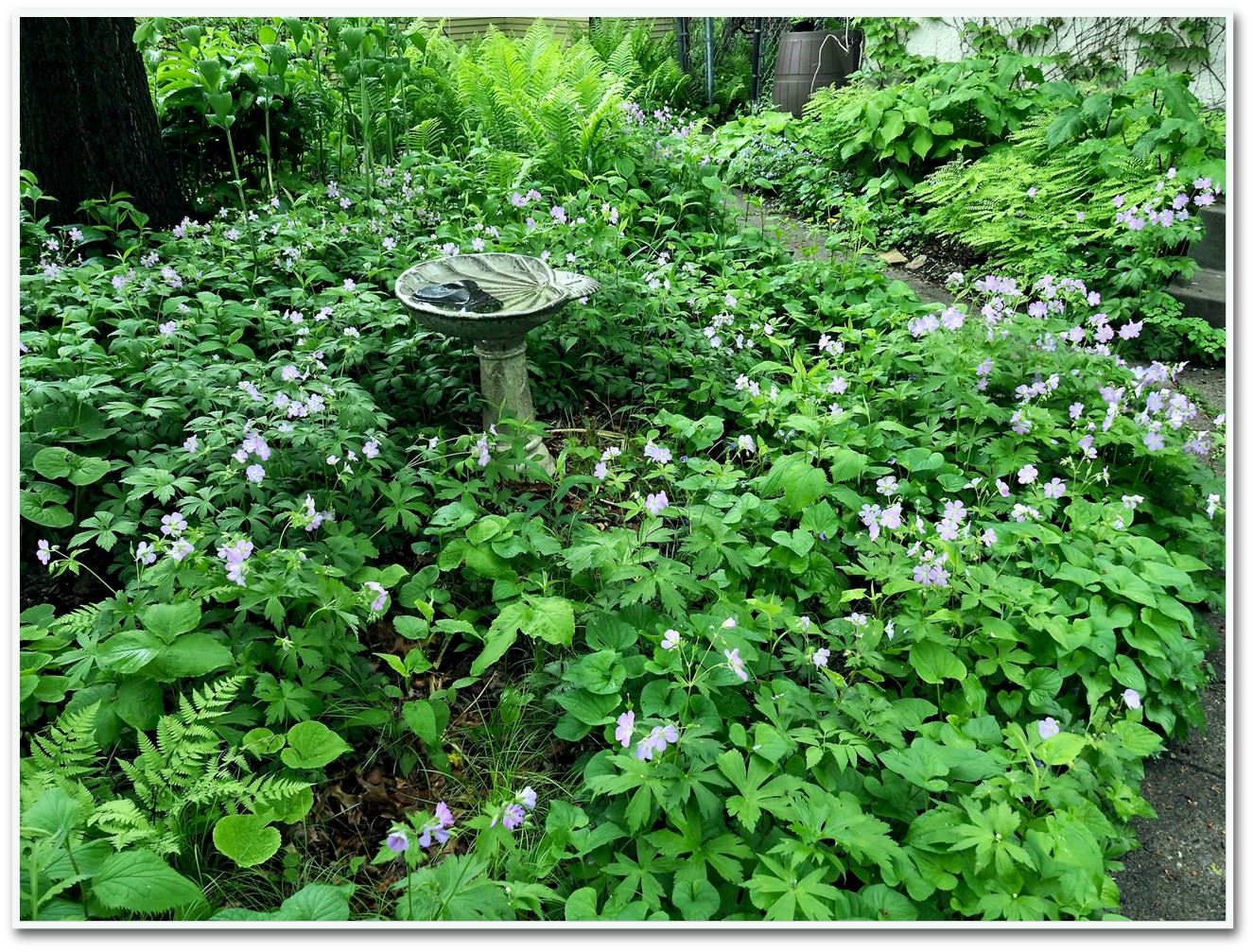
The spring bloomer list includes: Solomon’s Seal, Wild Columbine, Wild Geranium, Jacob’s Ladder, Meadow Rue, Jack-in-the Pulpit, Violets, Woodland Strawberry, Pennsylvania Sedge, Blood Root, Wild Ramps, Bellwort, Wild Ginger and Wild Blue Phlox.
Later in the year, Heart-leaved Aster, Big-leaved Aster and Zig-zag Goldenrod show up among the present Lady Ferns, Maiden Hair Ferns and sedge varieties.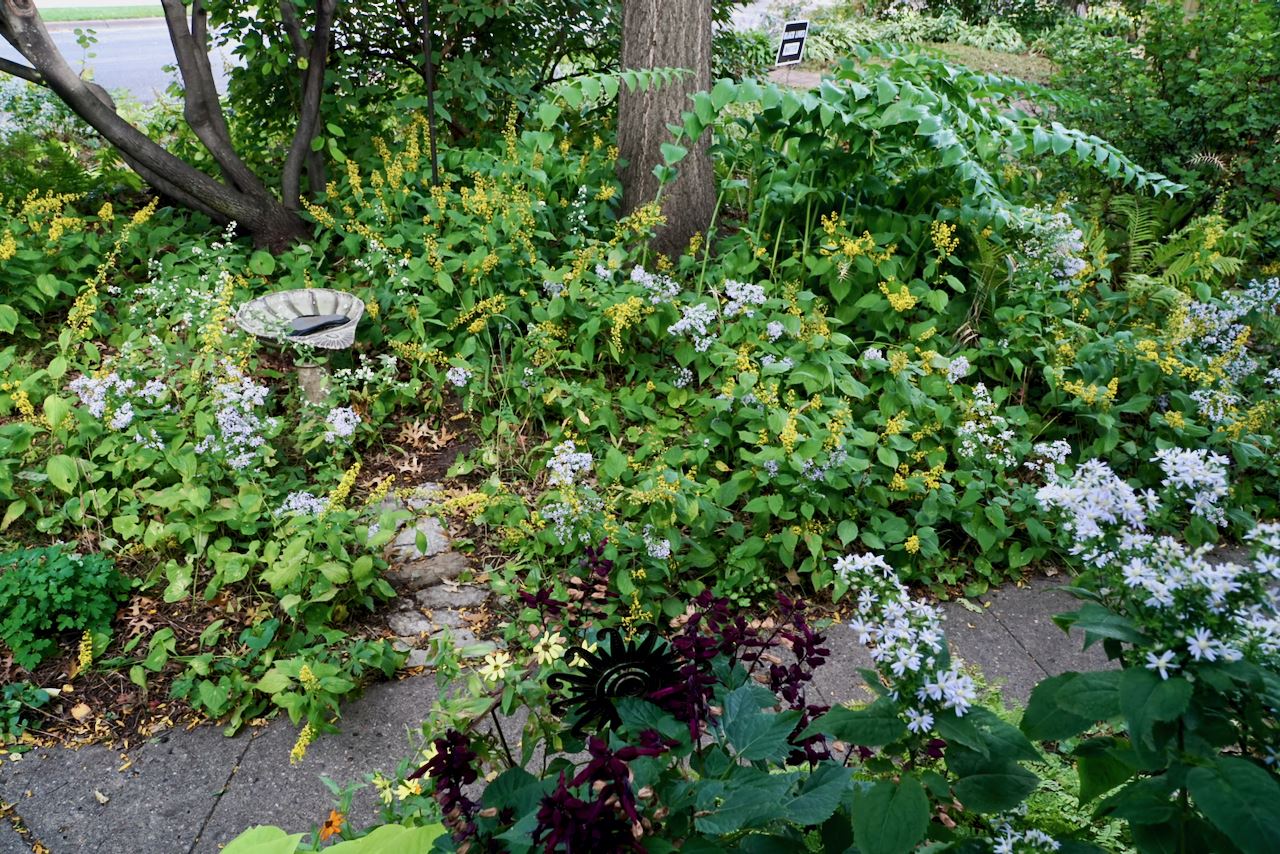
These plants thrive in our increasingly shady yard. The same plant species are prevalent in nearby wild areas along the Mississippi River. I have found this selection works quite well so the plan is to extend more on the increasingly shady southside that lies heavily shaded under our neighbor’s Sugar Maple. Since the neighbor is on board, we’ll plant in her yard too! This location of our next Soft Landings project is indeed, connecting and growing habitat!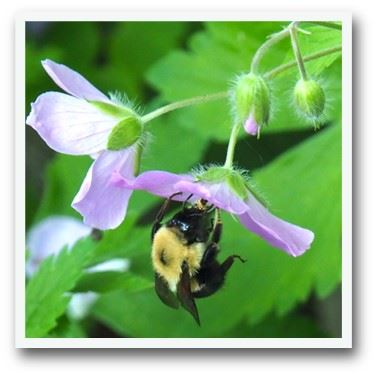

Watch a Douglas Tallamy video about native keystone plants.
https://www.nwf.org/Garden-for-Wildlife/About/Resources/native-keystone-plants
A photo shows the Soft Landings pictured previously. In front, is a sloped rock retaining wall, constructed with local limestone. Importantly, there is signage that tell passersby what this landscape is about - HABITAT! We maintain clean but natural edges.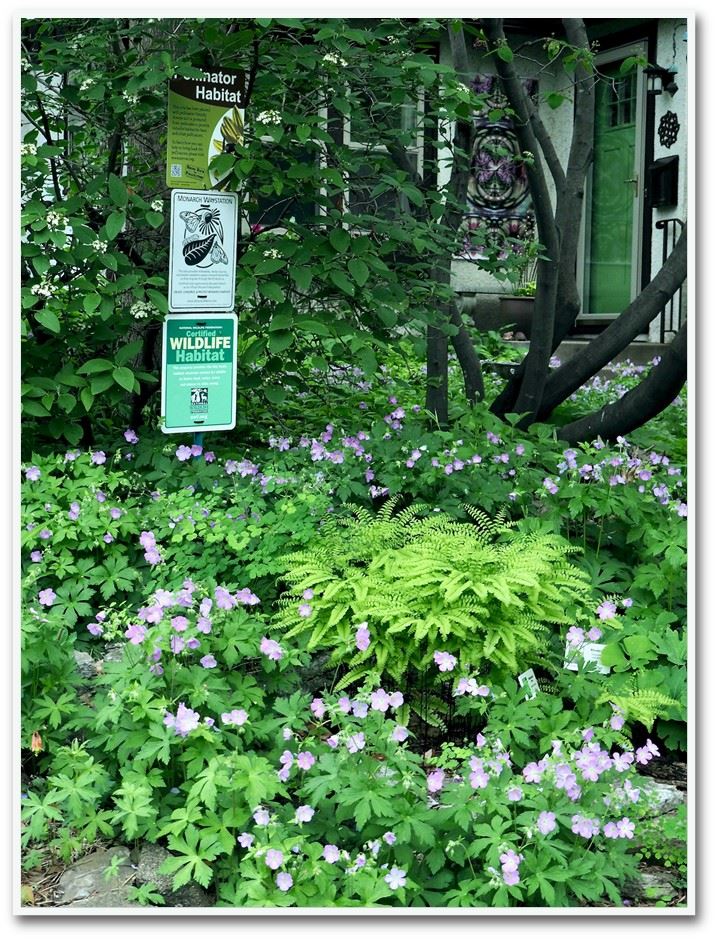
We also have a GROW HABITAT Free Info Box, conveniently located next to the sidewalk.
Here’s the lay of the land:
- We have no lawn, basically “green mulch” is provided by low groundcovers including Blue and Canada Violets, Woodland Strawberries and Wild Ginger.
- Fallen leaves are left as mulch to rebuild the soil, help retain moisture and provide insect habitat.
- Future plantings will be additionally mulched by oak leaves from nearby, as well as the maple.


- Log habitat features are in this area, now hidden under the snow.
- Native plants, preferring part-shade to shade growing conditions, here now include: Heart-leaved Aster, Zig-Zag Goldenrod, Elm-leaved Goldenrod, American Bellflower, Thimbleweed, Oval Sedge, Alumroot, Poke Milkweed, Lady’s Fern, Jack-in-the Pulpit, Wild Ramps. Dwarf Bush Honeysuckle is on a sunnier edge.

- A number of plants requiring more sun are here but not thriving. This area received more sun in earlier days before the maple shade grew. The species include Wild Bergamot, Culver’s Root, Brown-eyed Susan, New England Aster, and Common Milkweed. There was a Red-twigged Dogwood with changing conditions so we reluctantly removed last fall. We will eventually relocate plants not doing well.
- We are seeking native species to plant here that can tolerate drier soil conditions. Our soil is a little sandy and droughtier conditions have prevailed the last few years. Climate change is happening and we’re going to plant accordingly.
- We are looking for an understory tree or shrub to plant. Being considered at the moment, is the native Witch Hazel that is tolerant to a range of sun and soil conditions. It has ornamental value and the yellow flowers bloom in late fall, attracting the few remaining pollinators. Nice to end the season on a colorful bloom note!
- We did some Winter Sowing in containers this year that included Short’s Aster, a shady aster new to our yard and to be planted here.
- Next step is looking for plants to add diversity. A go-to resource is Prairie Moon Nursery catalog and is also online. https://www.prairiemoon.com We’ll be ordering their Bellwort for a dormant bare roots delivery. Their catalog helps me document and select our list of yard plants. We are fortunate to have many native plant nurseries in the area and we seek their offerings often. Wild Ones Twin Cities has many resources including a nursery guide and design templates. http://www.wildonestwincities.org
- Additional resources, including planting templates and plant lists, can be found on BWSR's Lawns to Legumes website
- During the next month, will be making further plans and selections!
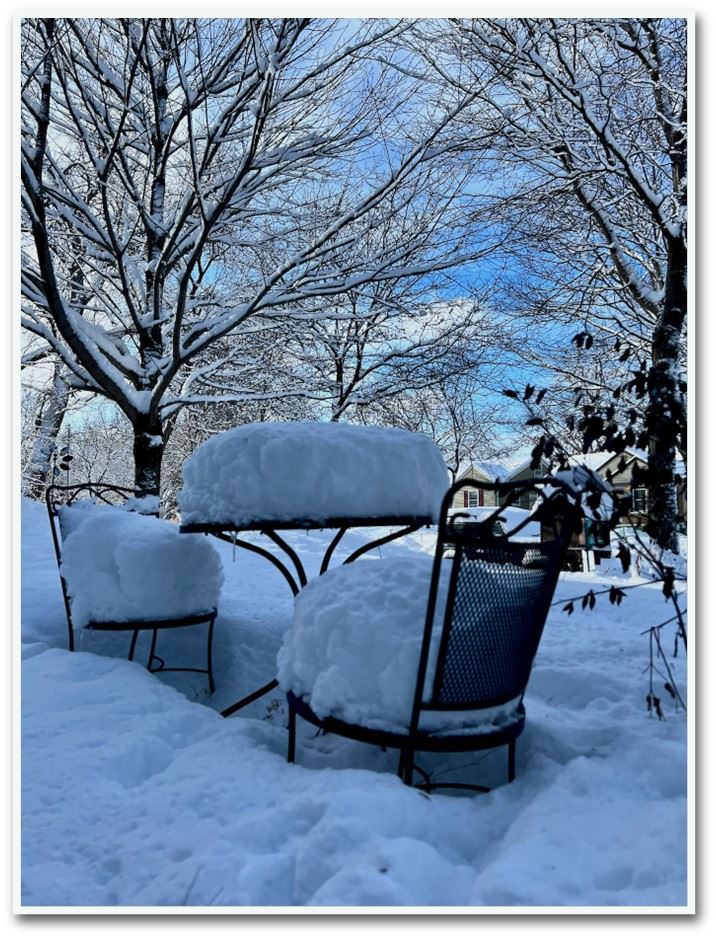
Workshop?
If there is interest, we could do an in-person workshop on design and plant selection. Please email Sue if you are interested in attending a workshop at our chapter.
Part 2- March 2023
Recap: This is the second article on the habitat gardening plans to augment a shady understory area beneath our neighbor’s Sugar Maple that extends into our bit of Minneapolis urban land. It’s a process! To learn more about Soft Landings and the project refer to the March blog.
A 2023 native plant catalog arrived in the mailbox today, and brought with it, a refreshed outlook. The cover photo featured American Bellflower (Campanula americana), whose deep blue blooms were being visited by the federally endangered Rusty Patched Bumble Bee (Bombus affinis). Double wow! This bellflower is not to be confused with the highly invasive Creeping Bellflower, (Campanula rapunculoides), seen throughout our area and zeroing in right next door. The captivating cover resonated on two opposing fronts. First, the American Bellflower does well in shade and is a welcome addition to a Soft Landings planting. Secondly, the Creeping Bellflower persists in my neighbor’s yard and managing this ecologically troublesome plant, is difficult and time consuming. * A job for the pitchfork, then down on your hands and knees, to dig through soil searching for every last remnant of the plant. (Our Chapter Caretaker, Paul Erdmann has renamed Creeping Bellflower- Creeping “Hellflower” and notes that it is one of the worst weeds at the Chapter, and it was likely planted by some good intentioned, but clueless, person). In that one glance at the catalog cover, I went through the glory and the pain of stewarding land. Yet not to be discouraged by creeping bellflower but encouraged by the potential our bit of land connecting with neighbor’s has now and can hold in the future.
Plant Considerations
With plant selection, I look into four main areas: what to keep, what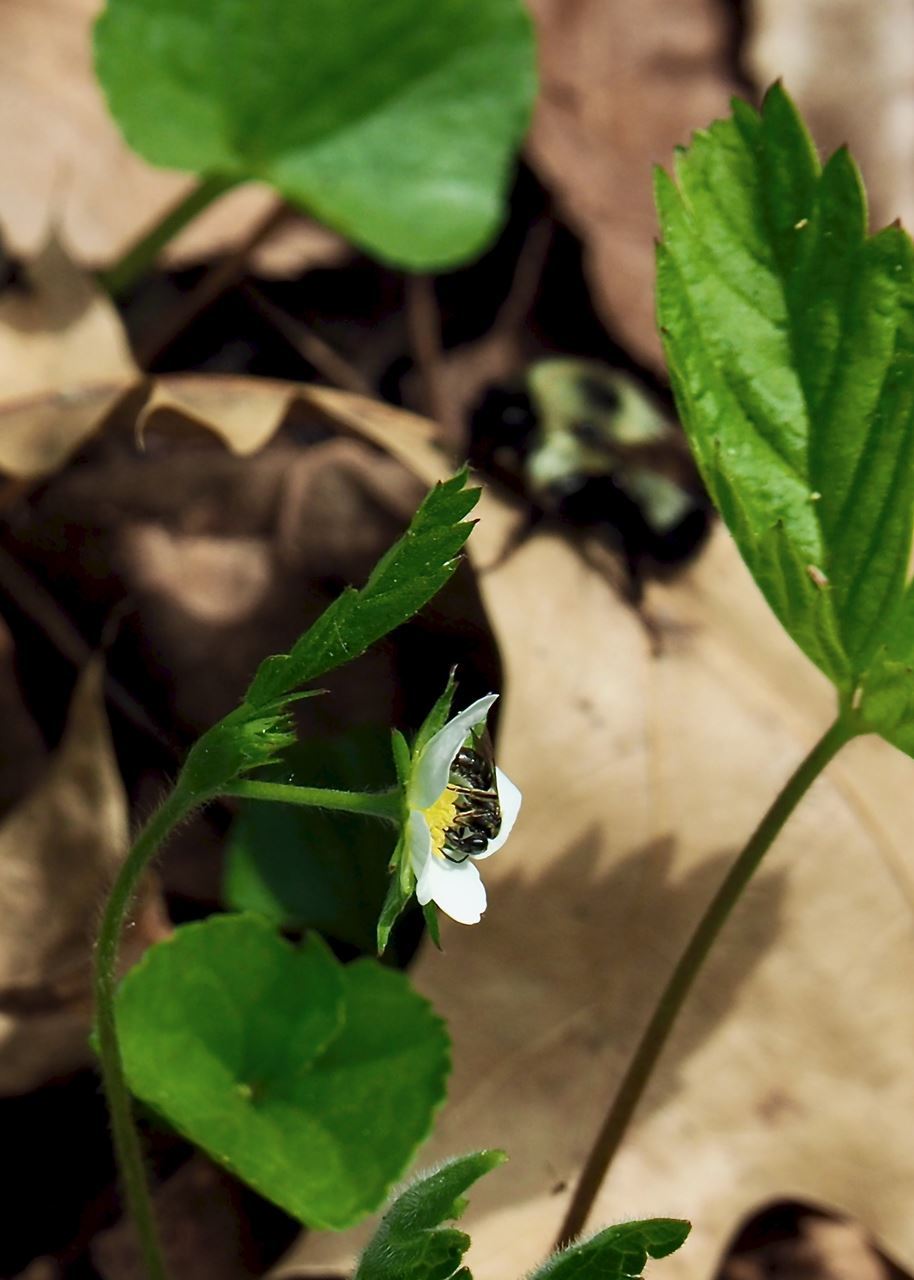 to add, what to manage (reduce or remove) and what do we especially wish to see take place at our place. What plants to keep are often those that are thriving. Why are they doing so well? What are the plant requirements in terms of light and soil conditions? How are they part of a developing plant community and what wildlife are they inviting? What plants to add, looks at the present plant community with an eye to what is realistically possible and then asks what is missing in seasonal blooms, in wildlife benefit, in canopy level (groundcover, plant heights, shrubs, tree) and design interest. What plants to reduce or remove, considers what over-zealous plants might be hindering a more biodiverse plant community and whether invasive plants are present that require management. Finally, a heartfelt look at what you enjoy having around your homeland, serves to inspire the planning process and encourage your curiosity to learn more. Ask yourself, “what do I love and want to see unfold on my bit of land”?
to add, what to manage (reduce or remove) and what do we especially wish to see take place at our place. What plants to keep are often those that are thriving. Why are they doing so well? What are the plant requirements in terms of light and soil conditions? How are they part of a developing plant community and what wildlife are they inviting? What plants to add, looks at the present plant community with an eye to what is realistically possible and then asks what is missing in seasonal blooms, in wildlife benefit, in canopy level (groundcover, plant heights, shrubs, tree) and design interest. What plants to reduce or remove, considers what over-zealous plants might be hindering a more biodiverse plant community and whether invasive plants are present that require management. Finally, a heartfelt look at what you enjoy having around your homeland, serves to inspire the planning process and encourage your curiosity to learn more. Ask yourself, “what do I love and want to see unfold on my bit of land”?
The Central Keystone Tree
This project centers on a Soft Landings planting beneath an existing.jpeg) mature Sugar Maple (Acer saccharum), a keystone species, a native plant all-star, as in highly significant (and often critical) to their food web. How is the sugar maple ecologically valuable? Beginning with the indigenous people, many North Americans, have a long history of harvesting and enjoying maple syrup. We easily recognize the awesome value of the Sugar Maple’s spectacular fall color. Yet, many of the ecological services aren’t so obvious. Bees, butterflies, and birds also drink in the energy-giving sap. Maples flower in early spring, attracting a variety of bee species including mining, sweat, cellophane and mason. The leafy foliage serves as the host plant food for over 220 moth and butterfly species in our area alone. This is vital to these lepidoptera insects AND to the food web. The National Wildlife Fund states that 96% of U.S. terrestrial birds rely on insects supported by keystone plants. These birds require a fatty, protein-rich food source to feed their young and nothing tops juicy caterpillars. The maple fruit is eaten by adult songbirds. Many birds like to nest in the trees, right alongside their food sources. The fruit, buds and twigs are eaten by several mammals including deer, chipmunks, and squirrels. Decomposing maple leaves enrich the surrounding soil by raising the soil’s mineral content and making it less acidic. This gives plant roots increased access to nutrients and water. Maples help prevent erosion sequester carbon and help manage storm water runoff - all with their expansive root system. Much of this done, all in a day, quite quietly.
mature Sugar Maple (Acer saccharum), a keystone species, a native plant all-star, as in highly significant (and often critical) to their food web. How is the sugar maple ecologically valuable? Beginning with the indigenous people, many North Americans, have a long history of harvesting and enjoying maple syrup. We easily recognize the awesome value of the Sugar Maple’s spectacular fall color. Yet, many of the ecological services aren’t so obvious. Bees, butterflies, and birds also drink in the energy-giving sap. Maples flower in early spring, attracting a variety of bee species including mining, sweat, cellophane and mason. The leafy foliage serves as the host plant food for over 220 moth and butterfly species in our area alone. This is vital to these lepidoptera insects AND to the food web. The National Wildlife Fund states that 96% of U.S. terrestrial birds rely on insects supported by keystone plants. These birds require a fatty, protein-rich food source to feed their young and nothing tops juicy caterpillars. The maple fruit is eaten by adult songbirds. Many birds like to nest in the trees, right alongside their food sources. The fruit, buds and twigs are eaten by several mammals including deer, chipmunks, and squirrels. Decomposing maple leaves enrich the surrounding soil by raising the soil’s mineral content and making it less acidic. This gives plant roots increased access to nutrients and water. Maples help prevent erosion sequester carbon and help manage storm water runoff - all with their expansive root system. Much of this done, all in a day, quite quietly.
The Soft Landings project aims to plant specific natives, surrounding this tree, so that beneficial insects that begin their life cycle in the upper tree canopy, can complete their life cycle below. This planting will also build a healthier soil, provide moisture-retaining green mulch, give food and shelter for a variety of pollinators, beneficial insects and birds, and further carbon sequestration.
Plant Stories
More diverse and effective habitats have varying height levels where wildlife can interact to find food and shelter. The Sugar Maple is providing the tallest level. In our spatially limited setting, there is room for one understory tree or a tall shrub, a bit past the Maple canopy dripline and also for several short shrubs nearby. Within the dripline area, plants of various heights and shorter ground covers will complete the layered stories. Small seedlings only will be planted within the dripline, to avoid digging into the ground too deeply and disturbing the maple roots.
Understory Trees and Shrubs
Our site specifics of partial shade to full shade and medium to medium/dry soil, plus wildlife value, narrow plant selection choices. At this time, a strong contender for a larger attractive shrub is Round-leaved Dogwood (Cornus rugosa), which does well in drier soil and less sun while offering strong wildlife and ecological value. Here is Prairie Moon’s write-up “This woodland understory tree-like-shrub has full-season interest: lovely white clusters of flowers in spring, bushy green foliage in summer, attractive berry-like drupe clusters in fall, and yellow-green branches with reddish-purple markings that are striking against the white winter snow. Round-leaved Dogwood prefers thin canopies with dappled sunlight and woodland edges. Sometimes this Dogwood will grow from one branch, appearing more like a tree. Other times it will grow from multiple stems, appearing more like a shrub. Pruning will encourage a more dense, shrubby appearance.
The Round-leaved Dogwood is a great plant for insects and wildlife. It is one of the host species for the Spring Azure butterfly and Gossamer Wing butterfly. The fruits are eaten by multiple species of grouse, and the twigs are eaten by mammals like deer and rabbit. In some Eastern states, Round-leaved Dogwood is rare or endangered.”
We currently have one shorter shrub variety in this area, Dwarf Bush Honeysuckle (Diervilla lonicera), an easy-to-grow shrub adaptable to many soil types and all light levels plus is drought tolerant. The flowers attract bumble bees, butterflies, moths and butterflies. Considering adding two more but need to factor growing spatial width since they are suckering plants. That could be an advantage on the sloped area. I bought this shrub at a new nursery in our Minneapolis neighborhood, The Agrarian, who have a good selection of natives.
Understory Forbs, Ferns, Sedges and Groundcovers
Awaiting the highly anticipated arrival of spring in our yard, means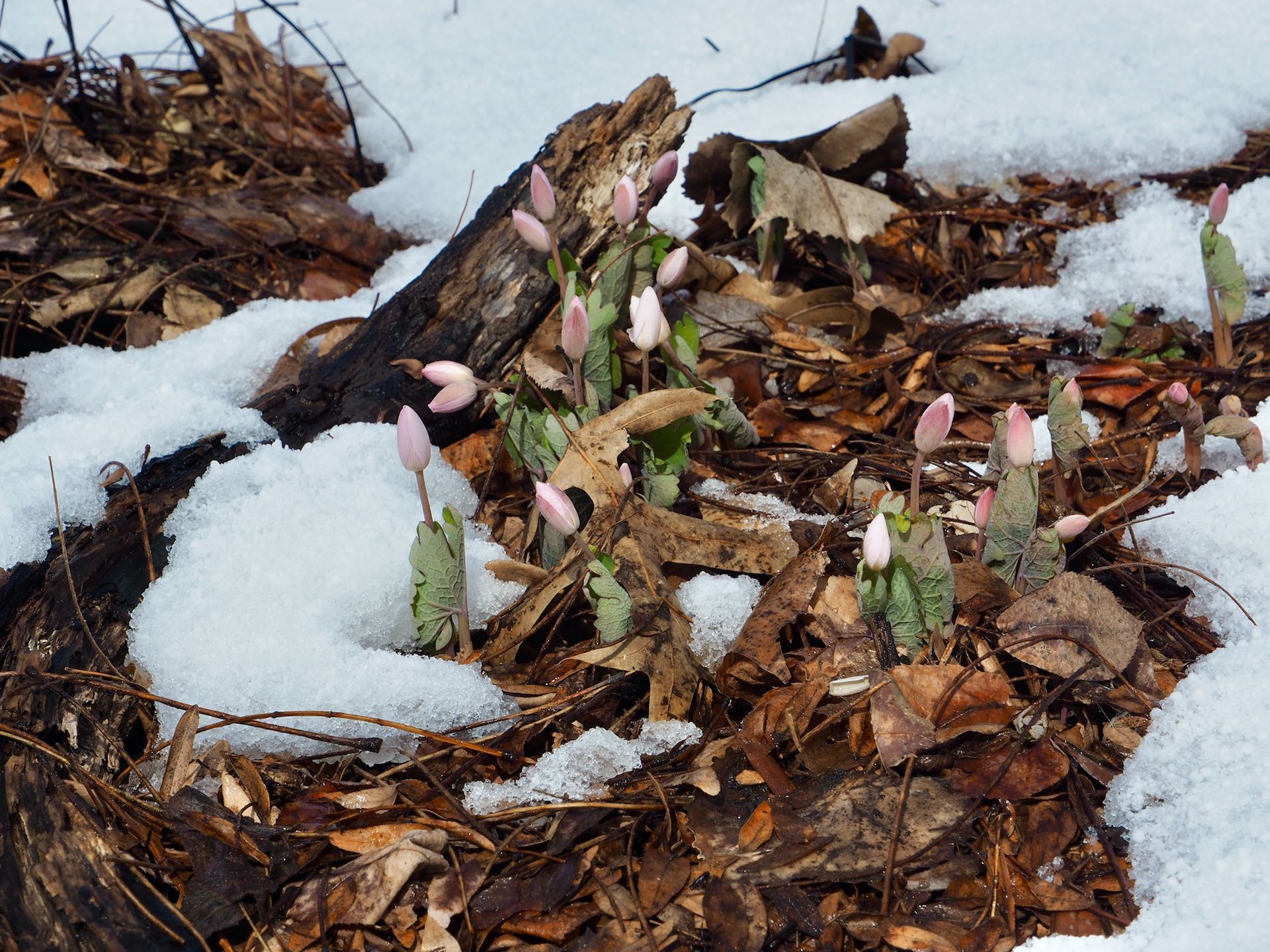 looking for the emergence of Bloodroot (Sanguinaria candensis), one of the first Minnesota native plants to bloom. The love of this plant influences some further understory planting deliberations. As the weather warms, we faithfully check the bloodroot progress from their leafy bed, happening anytime from late March to late April, depending on that year’s weather. Bloodroot has a sweet spot in our front rock garden’s north corner, nestled between Wild Ginger (Asarum canadense) and Maidenhair Fern (Adiatum pedatum). The newly inspired gardening plan is for the trio to have a spot on the south corner of the rock garden, which extends into the Maple Soft Landing’s location. These plants could attractively bookend our urban lot. No rigidity but a continuity that could help organize the small space. The plan is to gently dig-up, then divide some of the wild ginger and maidenhair fern, just as they break soil in the spring, their best time to transplant. We’ll wait to transplant Bloodroot, their best transplant time is early summer, when the plant is starting to go dormant.
looking for the emergence of Bloodroot (Sanguinaria candensis), one of the first Minnesota native plants to bloom. The love of this plant influences some further understory planting deliberations. As the weather warms, we faithfully check the bloodroot progress from their leafy bed, happening anytime from late March to late April, depending on that year’s weather. Bloodroot has a sweet spot in our front rock garden’s north corner, nestled between Wild Ginger (Asarum canadense) and Maidenhair Fern (Adiatum pedatum). The newly inspired gardening plan is for the trio to have a spot on the south corner of the rock garden, which extends into the Maple Soft Landing’s location. These plants could attractively bookend our urban lot. No rigidity but a continuity that could help organize the small space. The plan is to gently dig-up, then divide some of the wild ginger and maidenhair fern, just as they break soil in the spring, their best time to transplant. We’ll wait to transplant Bloodroot, their best transplant time is early summer, when the plant is starting to go dormant.
By propagating and transplanting natives that are growing well here, we are planting species that are suited to the site while saving money and avoiding plastic pot waste from purchased plants. There are other spring bloom plants that will be part of this plan. Wild Geranium and Solomon’s Seal will be divided and transplanted this spring. Jack-in-the Pulpit is better propagated from ripe seed gathered in early September. While Wild Columbine often produces seedlings, they don’t often transplant successfully, so will wait to collect seeds and winter sow for next year.
There is more on the Soft Landings plant wish list that will be either ordered bare root or purchased at a native plant nursery** or at one of the plant sales offered in the Twin Cities metro area this spring.*** I decided to see if a bare root, spring bloomer would be available now from Prairie Moon. Perusing their online catalog, I narrowed down to the best options that fit our site specifics, making good use of their filtering system (as Susan suggests, in her companion blog article). Plants were selected for our specifics: part-shade and shade, medium and medium-dry soil moisture, Minnesota native range, bloom time April - June, a range of heights, attractive to pollinators and birds, and finally, growing zone 4. Thirty-six plants presented themselves, but the choice narrowed to one - Bellwort (Uvularia grandiflora), an early spring bloomer, is shipped as a barre root plant, i.e. a dormant live root, packed in peat moss. This is what Prairie Moon had to say “Bellwort is an excellent early-blooming native shade plant for the woodland garden, shaded border front, wildflower garden or naturalized area. It spreads slowly by rhizomes so you can achieve a mass planting look under shade trees or along wood margins in a relatively short amount of time. The Bellwort flowers and leaves have an overall droopy appearance when in bloom. However, after seeds are set, the leaves of Uvularia take on a different look, somewhat like a needle threading the stem through the leaves…..Bumblebees, Mason bees, Halictid bees, and Andrenid bees feed from the nectar and collect pollen from the flowers which bloom April to May. Uvularia grandiflora is easily grown in average, well-drained soil in partial to full shade.” Our yard is home to several Bellworts on the northside Soft Landings. Now to introduce to the southside.
Several low-growing ground covers make their way around our yard,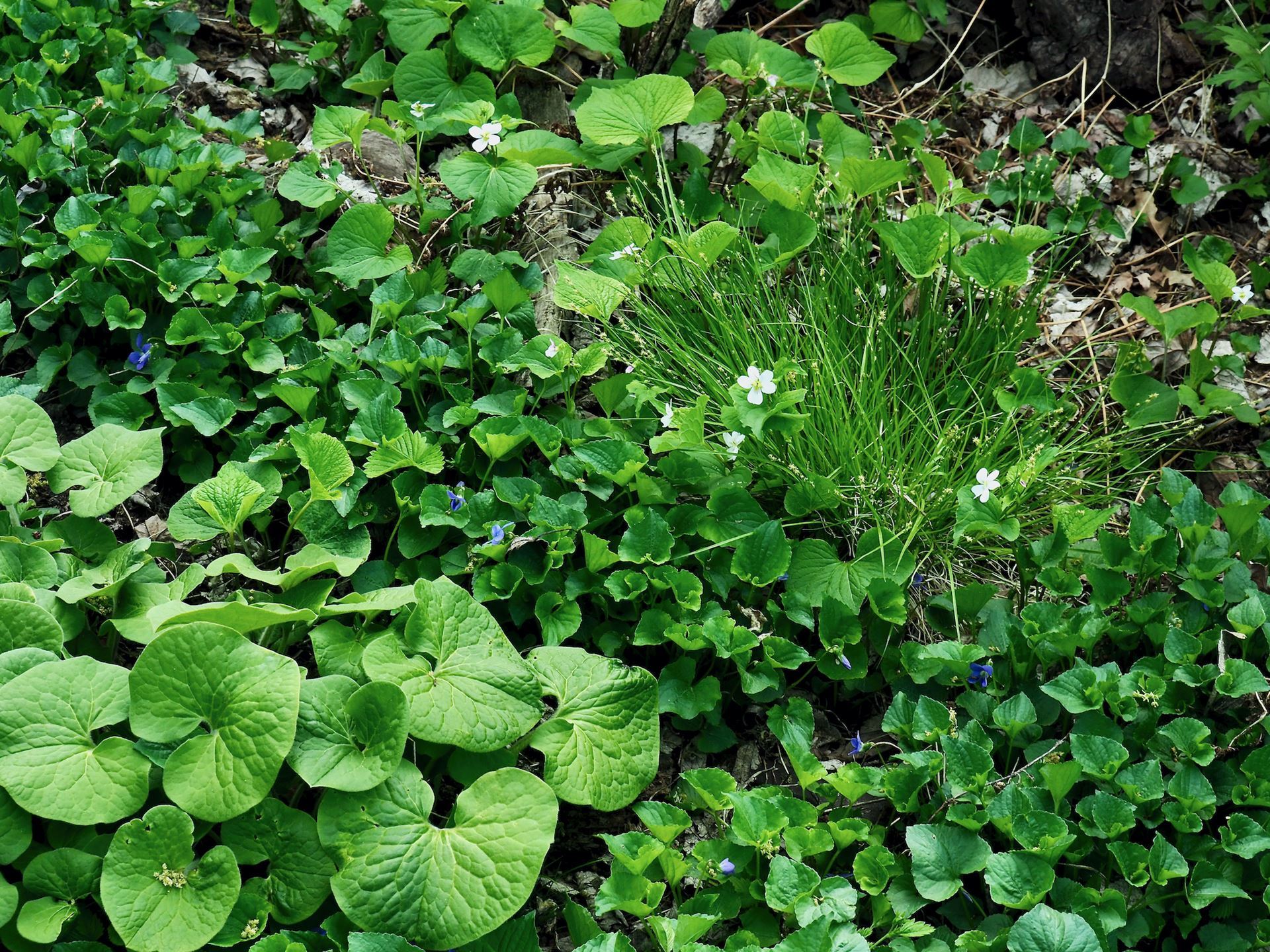 and I am grateful for their multiple ecological services. Common Blue Violet, Canada Violet, Pennsylvania Sedge, Ivory Sedge and Wild Strawberry stand out. These plants are valuable as insect host plants, wildlife food resources, green mulch, garden edging and more. This spring, I’ll be helping them meander to select spots, including to the Sugar Maple Soft Landings.
and I am grateful for their multiple ecological services. Common Blue Violet, Canada Violet, Pennsylvania Sedge, Ivory Sedge and Wild Strawberry stand out. These plants are valuable as insect host plants, wildlife food resources, green mulch, garden edging and more. This spring, I’ll be helping them meander to select spots, including to the Sugar Maple Soft Landings.
These are the current Soft Landings planting plans, top-to-bottom. More to grow on next month!
* The University of Wisconsin Extension has a pdf that offers several ways of managing creeping bellflower including the non-chemical method by thorough removal of all rhizomes and perennial roots.
** Most native plant nurseries are located outside of the city. I suggest taking this opportunity to visit natural areas near them, and to experience evolved native plant communities. Inspirational and educational! A visit to Outback Nursery then entails a trip to Grey Cloud Dunes, Landscape Alternatives then visit Interstate Park, Prairie Restorations on to Sherburne National Wildlife Refuge - you get the idea!
*** At the Landscape Revival on June 10th, you can meet a number of growers, native plant experts and purchase plants in one place.
Part 3-April 2023
Native Plant Gardening is Habitat Gardening
The April Fool’s Day winter storm of 8.5” of heavy, wet snow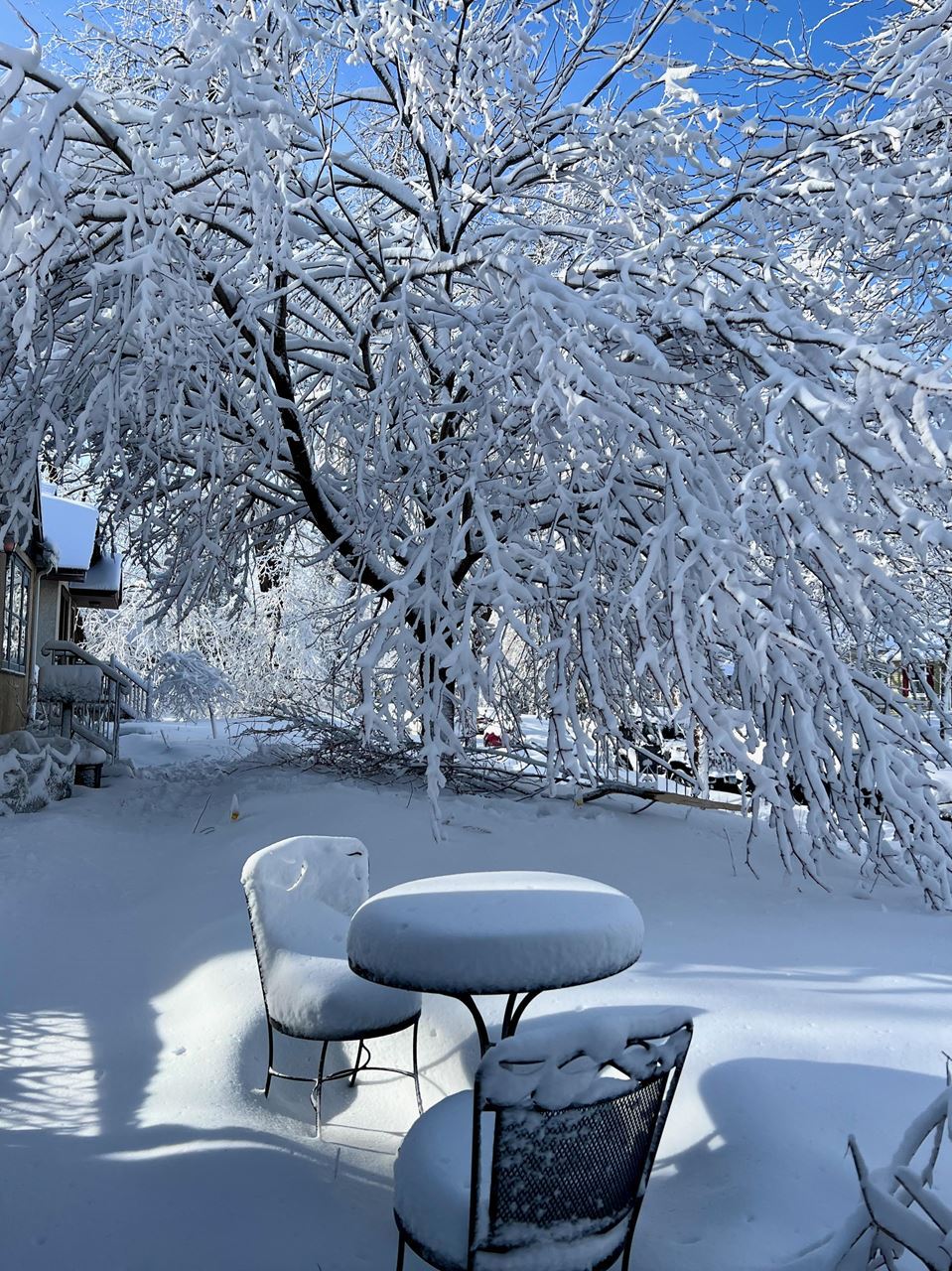 probably didn’t take many Twin City natives - plants and people - by surprise. The clean, white blanket of snow decorating the landscape was beautifully awesome and increased water tables suffering from a few years of drought. Unfortunately, the weight of the thick snow coating was too much for many tree and shrub limbs. The neighbor Sugar Maple lost a couple of large limbs yet should weather the damage.
probably didn’t take many Twin City natives - plants and people - by surprise. The clean, white blanket of snow decorating the landscape was beautifully awesome and increased water tables suffering from a few years of drought. Unfortunately, the weight of the thick snow coating was too much for many tree and shrub limbs. The neighbor Sugar Maple lost a couple of large limbs yet should weather the damage.
The storm-downed tree limbs in the neighborhood did offer the opportunity to find a few sculptural tree limbs to add to the new Soft Landings site. Besides adding natural interest, the wood is a beneficial insect habitat feature.
On March 28th, 2023, my son took this photo of a newly eclosed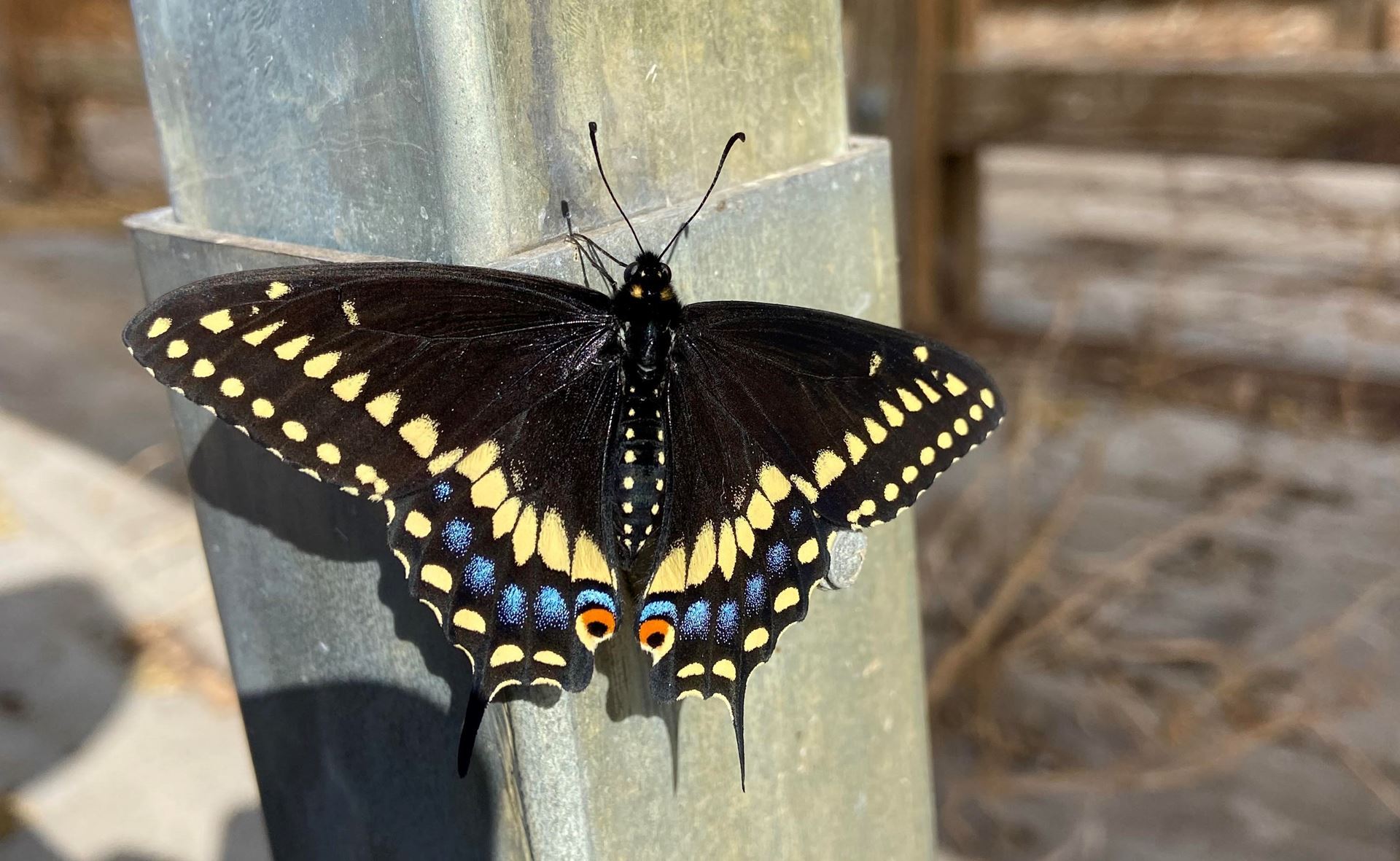 Black Swallowtail, seen at his Rushford MN farm, an hour’s drive from the TC area. Insects over-winter in a variety of forms and ways. The Black Swallowtail, shown here, overwinters as a chrysalis and could be hidden among plant stems & branches, under an eave or another protected spot. Please, Do Not Disturb!
Black Swallowtail, seen at his Rushford MN farm, an hour’s drive from the TC area. Insects over-winter in a variety of forms and ways. The Black Swallowtail, shown here, overwinters as a chrysalis and could be hidden among plant stems & branches, under an eave or another protected spot. Please, Do Not Disturb!
The juxtaposition of these two MN occurrences underscores a vital habitat point in spring gardening. As far as hands-on-gardening goes, take it slow & easy until mid-May. April and early May are good times to observe what is coming up in your yard and think further about the landscape you envision. Don’t rake and tromp around on wet soil. Prune with caution, looking for hidden chrysalis and more. Maintaining a native garden is like traditional gardening in some ways but has essential differences that place us within nature. How to care for plantings in a way that recognizes leaf litter, stems, and grass clumps as homes for beneficial wildlife and still have a tended, manageable landscape? How to encourage a local ecology to thrive? How to know when to step aside, observe what is happening and let the process unroll?
This is a Great Spangled Fritillary caterpillar that overwinters as a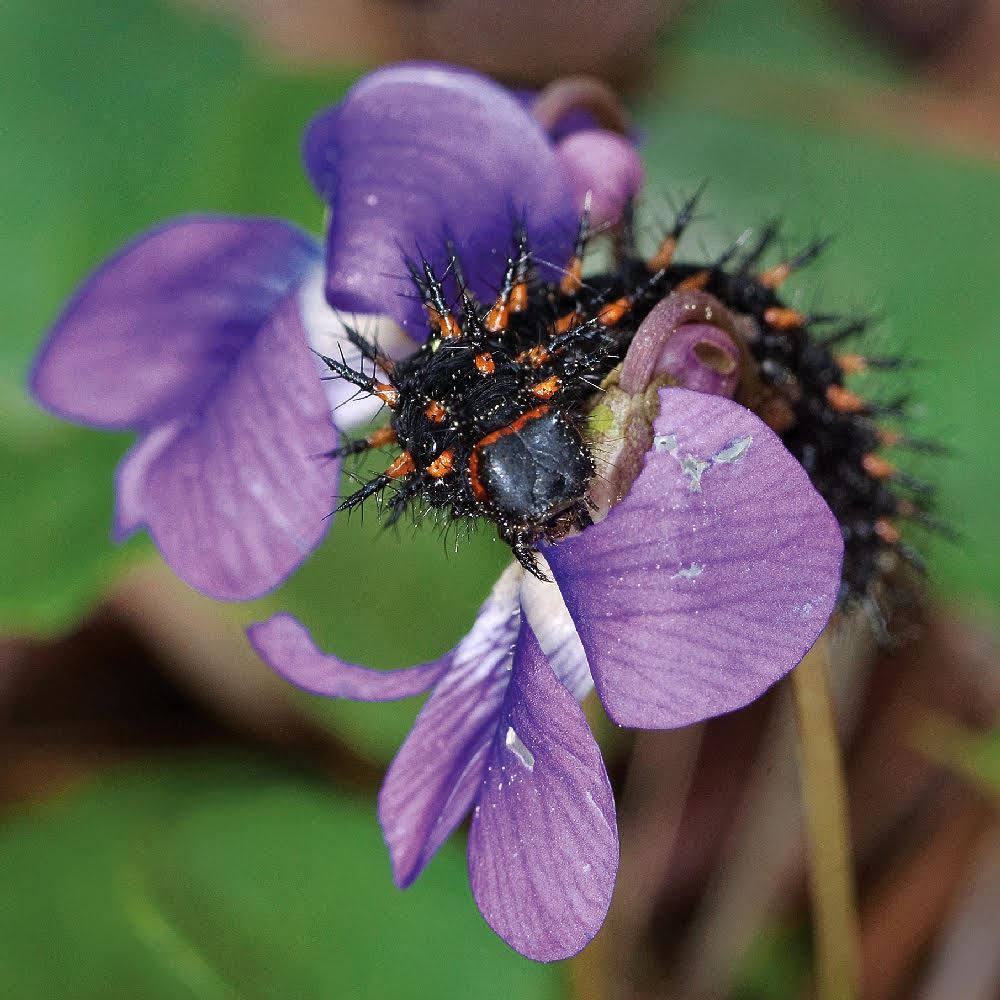 tiny caterpillar on or near violets, their only host plant. No violets=no fritillaries. So don’t mess with the violets in the spring! Photo by Sara Bright, Alabama Butterfly Atlas, used with permission.
tiny caterpillar on or near violets, their only host plant. No violets=no fritillaries. So don’t mess with the violets in the spring! Photo by Sara Bright, Alabama Butterfly Atlas, used with permission.
Useful PDFs: a US Forest Service colorful habitat garden diagram “Attracting Pollinators to Your Yard Using Native Plants” and an article written by me, "Spring and Fall Habitat Garden Care for Pollinator Conservation” for the Nokomis Naturescape.
Further Plant Considerations
Planning early helps one mull the choices. As stated last month, we will make use of plants proliferating and what flourishes. This will add a nice continuity joining our yard with our neighbor’s. We’ll see what the next month brings in transplanting from our yard to next door.
When choosing plants for within the maple tree’s dripline, it is vital to plant small seedlings so tree root disturbance is minimal - use a trowel and plant 3 feet away from the trunk (more info on Soft Landings).
We will also enjoy spreading something newer to the landscape, such as Bellwort (commonly called “Merry Bells” which you give you the idea they are delightful plants). The bare root plants are expected to arrive from Prairie Moon soon.
In the next month, I’m envisioning a couple of native plant nursery trips, to Outback Nursery for shrubs and a wildflower hike in nearby Grey Cloud Dunes to look for Pasque flowers and also to Prairie Restoration in Princeton with a jaunt to Sherburne National Wildlife Refuge’ s Wildlife Drive.
Sue Van Baerle and I will both have tables at Wild Ones Twin Cities “Spring Native Plant Resource Fair” at the Wood Lake Nature Center in Richfield, on April 18th, 6-8pm. Come by and say “hi” and see all that the gathering has to offer. Bush Lake Izaak Walton will be represented too! Click here for more info.
Part 4 - May 2023
One of the biggest perks of being a native plant habitat gardener is welcoming back the overwintering plants, seeing who’s there, how they fared and observing who is visiting them. What’s not to love about this time of fresh greenery, early bloomers, arriving insect life and migrating birds?
At our home front, the existing Soft Landings (SL), is doing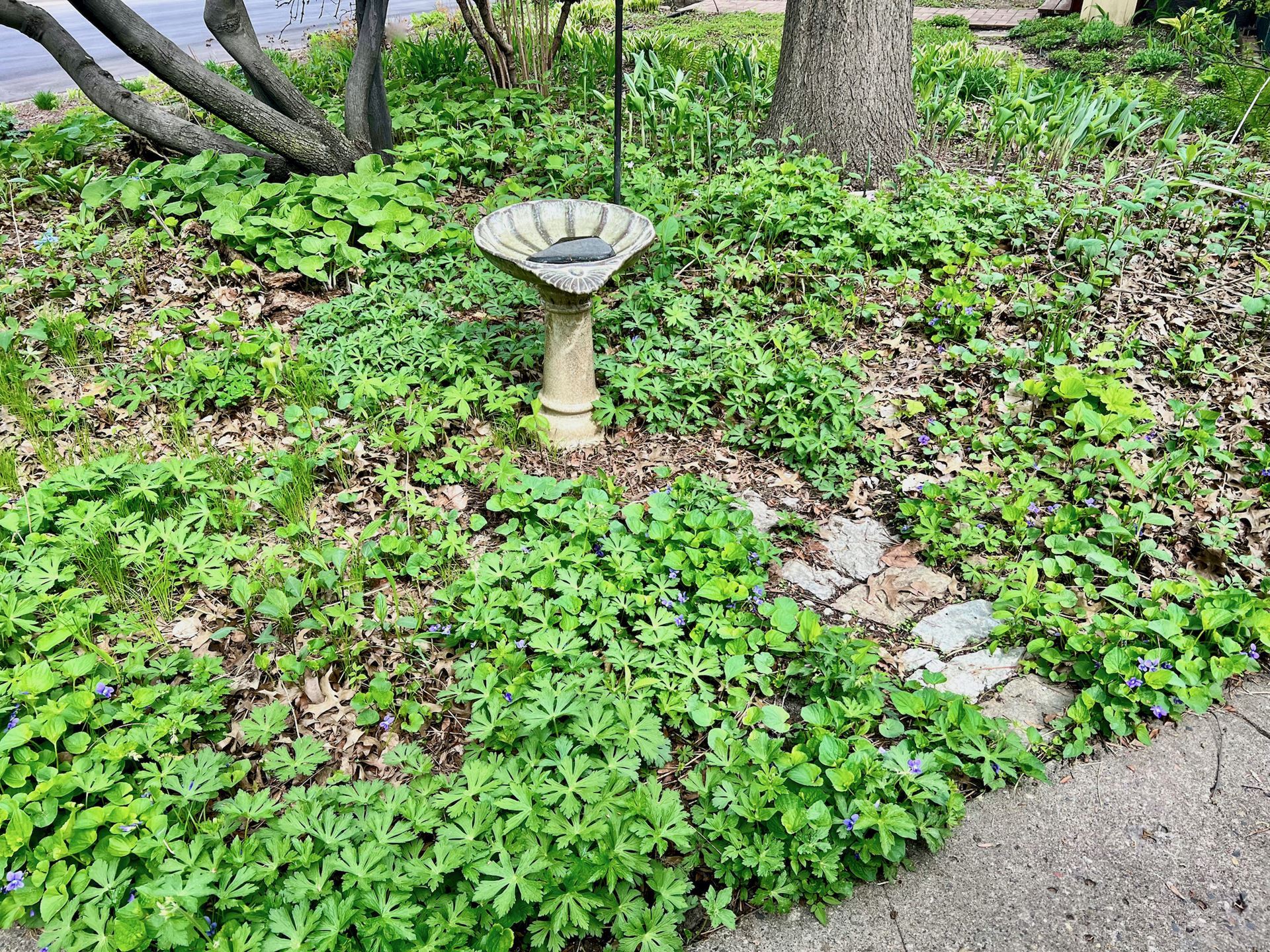 wonderfully and looking like the established, dynamic native plant community we intended. This SL acts as a template and a plant resource center for the new planting. In the rock garden along the public sidewalk, we added plant ID signs and also have a Habitat Garden Info box. This week we learned that a couple on the block is adding a pollinator native plant boulevard and were influenced by our yard and available info. Now that’s encouraging!
wonderfully and looking like the established, dynamic native plant community we intended. This SL acts as a template and a plant resource center for the new planting. In the rock garden along the public sidewalk, we added plant ID signs and also have a Habitat Garden Info box. This week we learned that a couple on the block is adding a pollinator native plant boulevard and were influenced by our yard and available info. Now that’s encouraging! 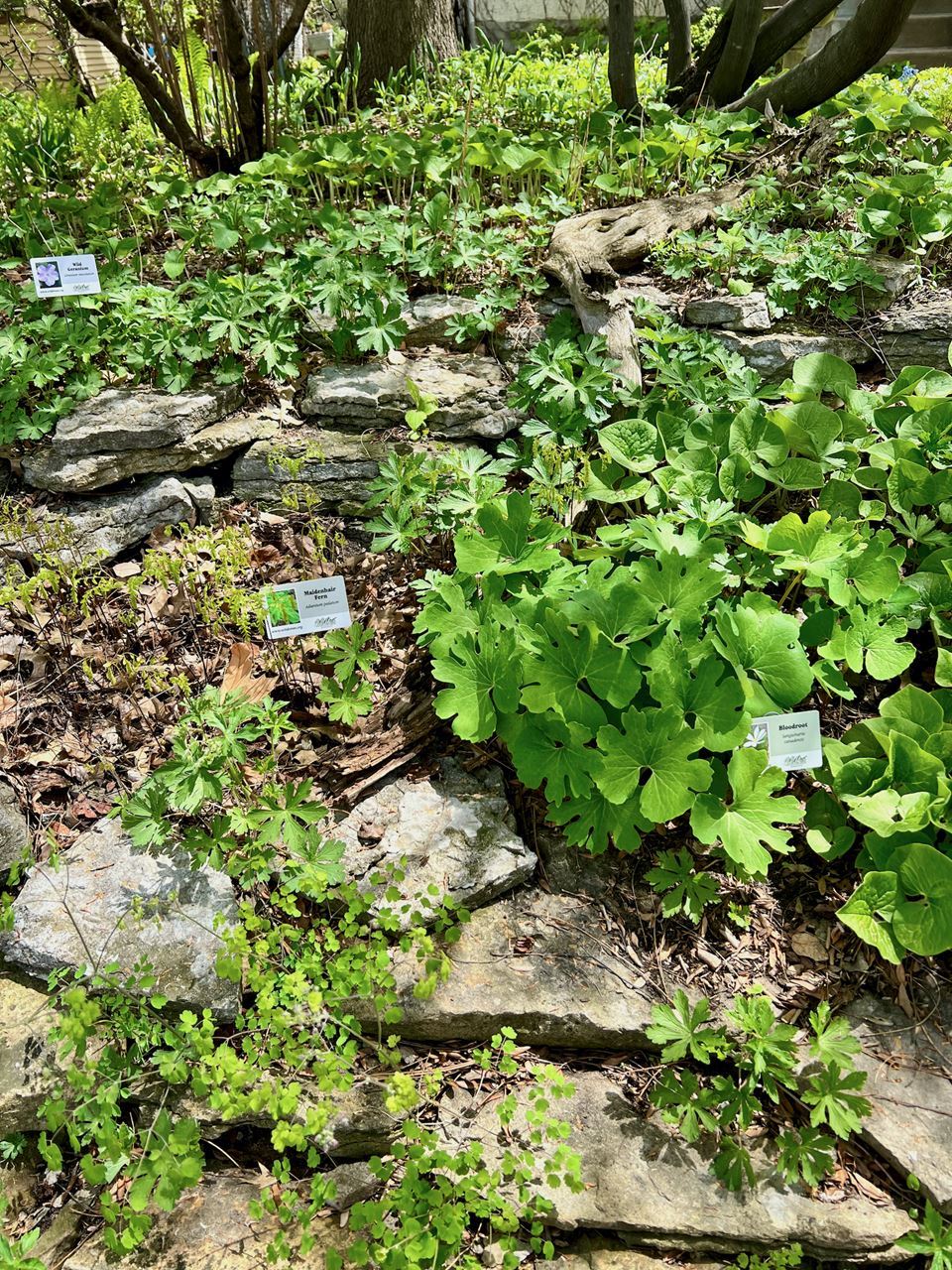
The new shady Soft Landings is of special interest with the goal of documenting the existing plant life, further consider new additions and design options. The area under the maple in our neighbor’s yard is returning nicely. Plants from our yard were allowed to spread in previous years, either on their own or with a little two-legged help. There is the expected meandering of wild ginger, wild geranium, zig-zag goldenrod, heart-leaved aster, and common blue violets. The ostrich fern had spread, surprisingly more this year. They are delightful in spring/early summer yet tend to dry out as the season progresses. This may not be the best place for them but they’re staying put now. The unwanted creeping Charlie and tree seedlings were sparse and easily manageable. Notably, the sloped area with west sun exposure, had a thriving population of migrated and robust thimbleweed.
The early May plan included augmenting this area with several species of early spring blooming transplants from our garden; Wild Ginger, Wild Geranium and Solomon’s Seal. I planted about thirty small starts that would require little digging and maple root disturbance. The Solomon’s Seal will stand tall next to the tree trunk, the Wild Ginger went to a bare “mound” and the Wild Ginger at base of slope near the log and rail tie border, that also serves as a narrow gardening walkway.
When transplanting the wild geranium, I heard a familiar buzz and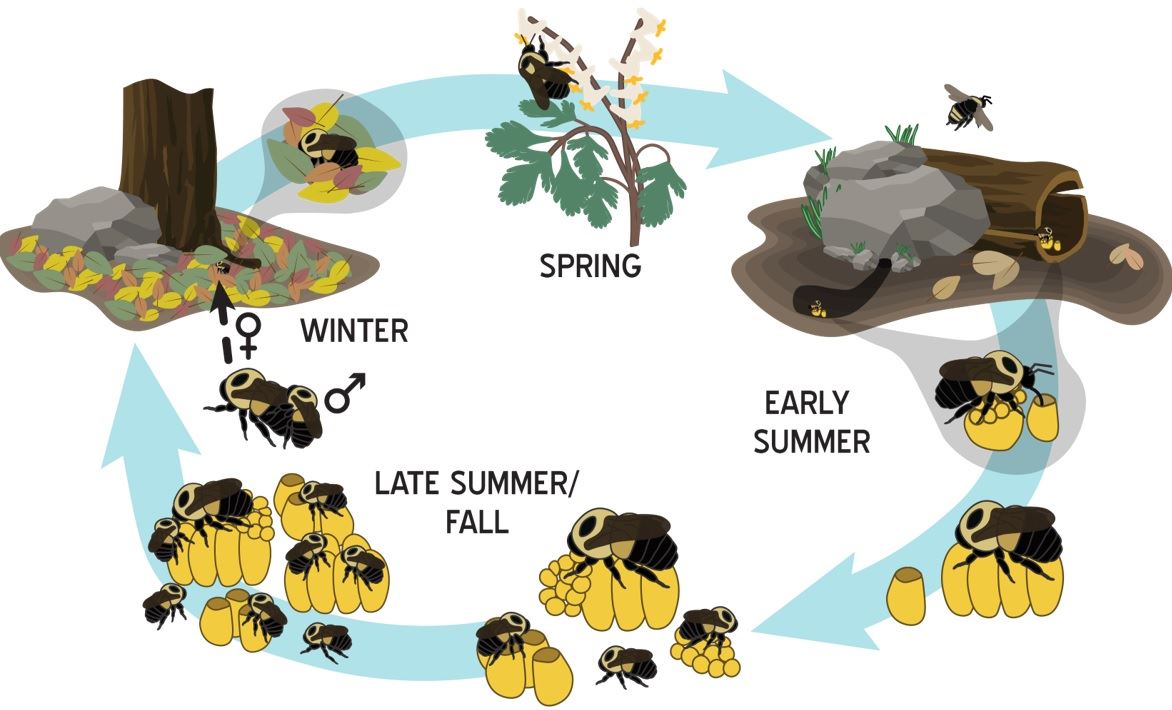 immediately knew this had to be a queen bumble bee. Sure enough, there she was and I had the opportunity to take a photo with the handy-dandy cellphone. How reaffirming! Our garden areas are effective queen overwintering sites. One suspected site was where I was - the rail tie and small log border that is acts as a fallen leaf catch basin. I will tread carefully here and was reminded to add a few stepping stones to make that easier. Knowing the life cycle of garden inhabitants helps one learn what to look for and then find ways to safeguard their homes.
immediately knew this had to be a queen bumble bee. Sure enough, there she was and I had the opportunity to take a photo with the handy-dandy cellphone. How reaffirming! Our garden areas are effective queen overwintering sites. One suspected site was where I was - the rail tie and small log border that is acts as a fallen leaf catch basin. I will tread carefully here and was reminded to add a few stepping stones to make that easier. Knowing the life cycle of garden inhabitants helps one learn what to look for and then find ways to safeguard their homes. 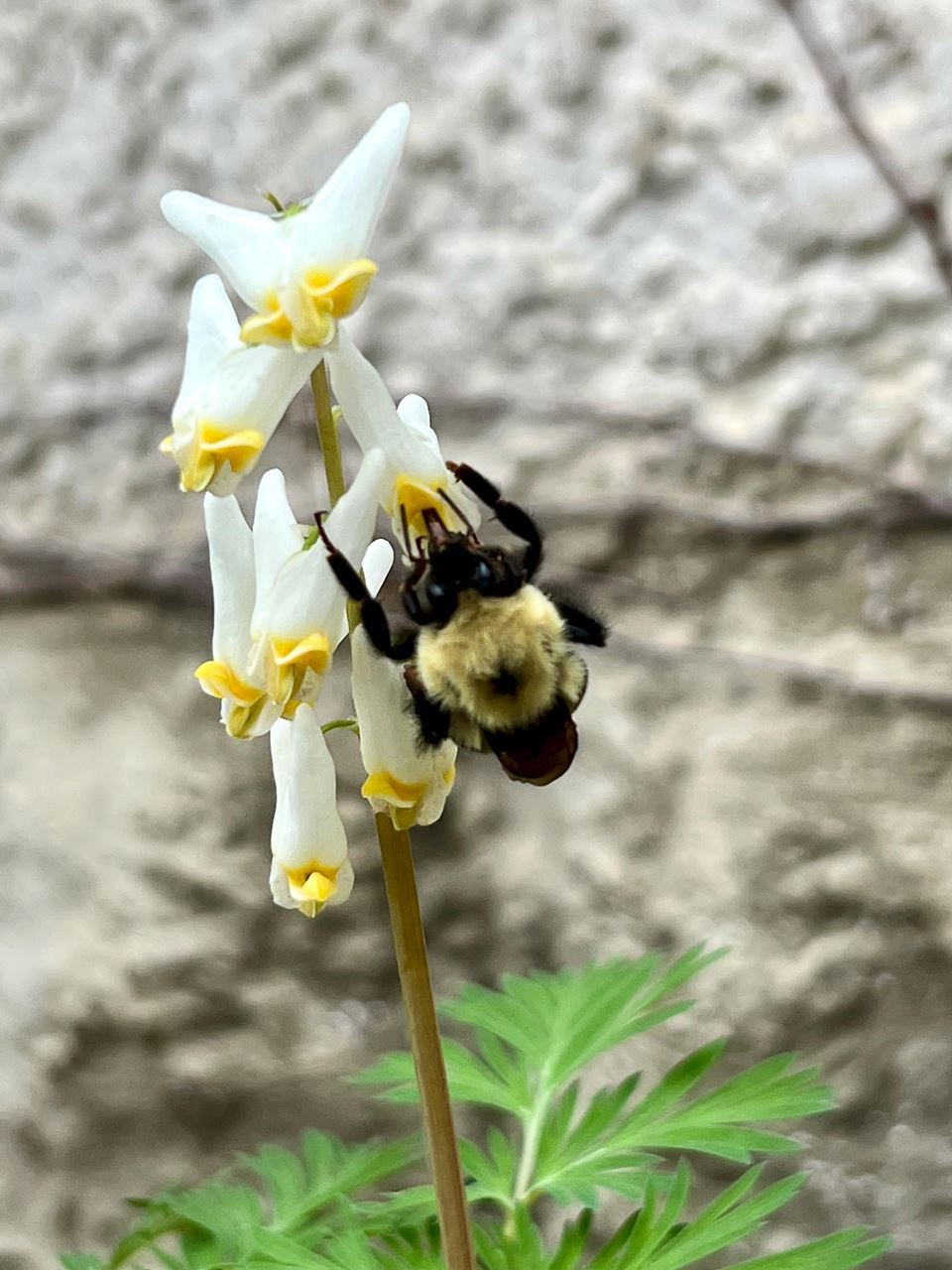
Weaving throughout and showcased on the edges of the Soft Landings planting, are species that serve beautifully as Green Mulch, a term to signify a low-growing planting that holds moisture and soil in place. Click here to learn about Green Mulch. Our SL sites will hold about a half dozen plant varieties including woodland sedges.
The search continues for a smaller variety understory tree or shrub, a keystone species that is either a dogwood or serviceberry. This will be a focal point of the Soft Landings edge that extends into our yard. We are looking for a 2 gallon size shrub or 5 - 7 gallon tree, larger size for more immediate presence. There is something to be said for planting smaller/younger, as to allow the plant to mature in place, yet have to admit, I am looking forward to having a bit of show here. For now, am in a holding pattern, since native plant nursery options are very limited at this time.
The week ahead holds a few opportunities to research and to add plant selections. First, Wild Ones Twin Cities is offering a program on Tuesday May 16th, is “A - Z on Sourcing Minnesota Plants”. This program may attended in-person, watched in zoom or taken in later via YouTube. Then, on Saturday, May 20th, will head to Burnsville Native Plant Market to explore possibilities and then on to Sogn Valley native plant sale to pick up a preorder, maybe be persuaded by a few more plants and then on to Nerstrand Woods State Park for inspiration.
Part 5-October 2023
The 3rd Summer of Drought: The entire summer was over-shadowed by the dreadful drought’s ongoing toll on plant life and the accompanying concerns of what’s ahead in our changing climate. Finally, the Minneapolis area received substantial rain at the end of September, more than we experienced all summer long. The land and our souls soaked in the healing water. While more rain is sorely needed to make up the deficit, plant life now has a fighting chance going into the winter season.
The small size of our urban lot gave us the ability to water judiciously and purposefully to keep the plants blooming and seeding for wildlife and to relieve the stress on trees, an essential part of the water cycle. Additionally, the Soft Landings shade plantings themselves act as a protective green mulch (see Part 4 above) to retain moisture. 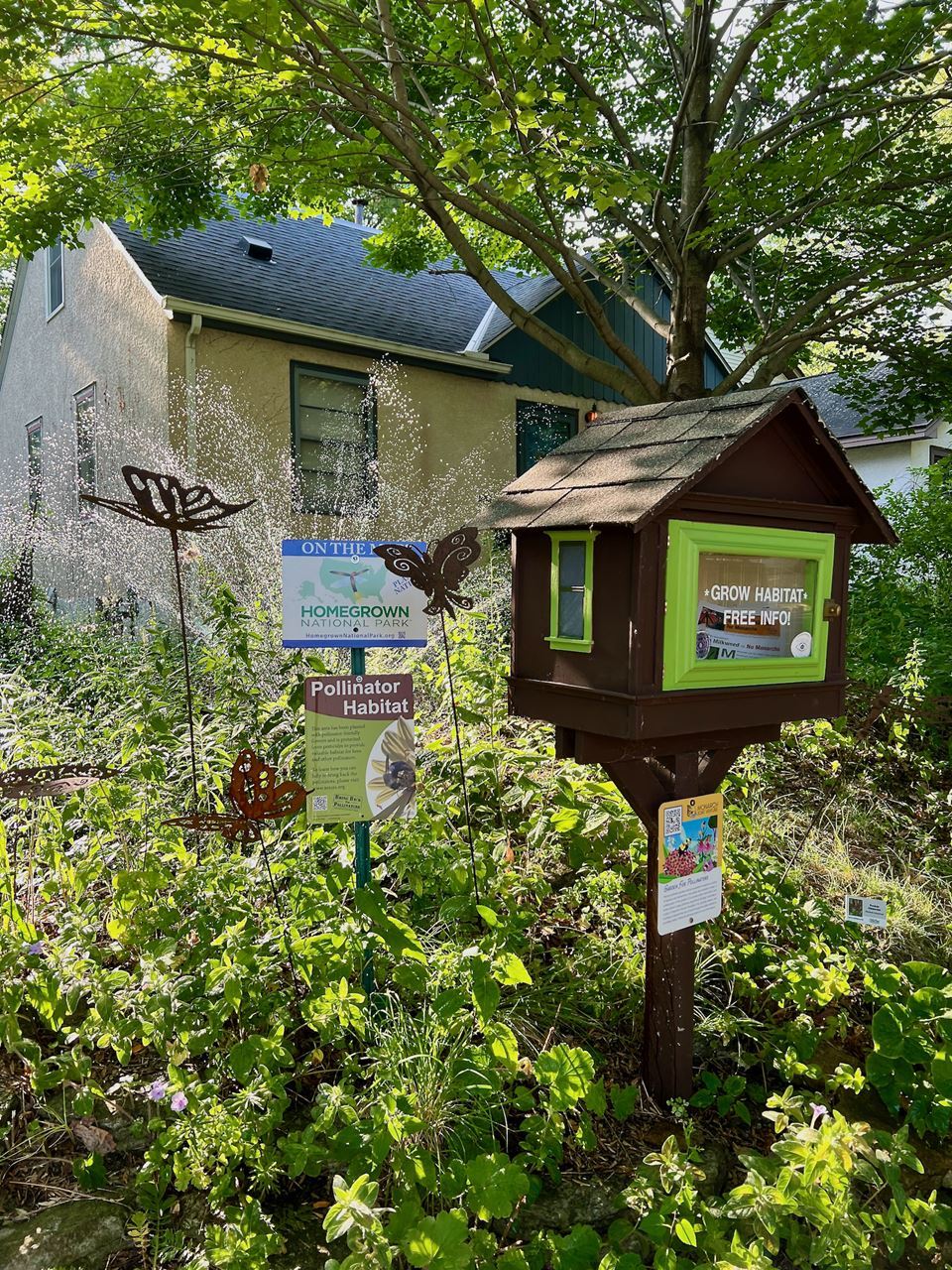
Our neighbor is quite enthused about the Soft Landings project and proudly made a Facebook post about it!
Drought Hardy Plants: Late summer and early fall is the time of goldenrods and asters. Our yard is heavily sprinkled with the wandering lavender-hued heart-leafed and large-leafed asters, that happily mingle with the yellow zig-zag and elm-leafed goldenrods. I enjoy the colorful continuity and so do the pollinators. Truly our yard is abuzz with this diversity of pollinator life. We definitely see more condensed insect life here, now, than any other landscape we enter. I am compiling a photo journal, together with a list of those invertebrates we can now call by name. (See the photo of a bumble bee looking at the Four-toothed Wasp. Earlier this summer, we reported a siting of this wasp, that may be the first record in Minnesota! )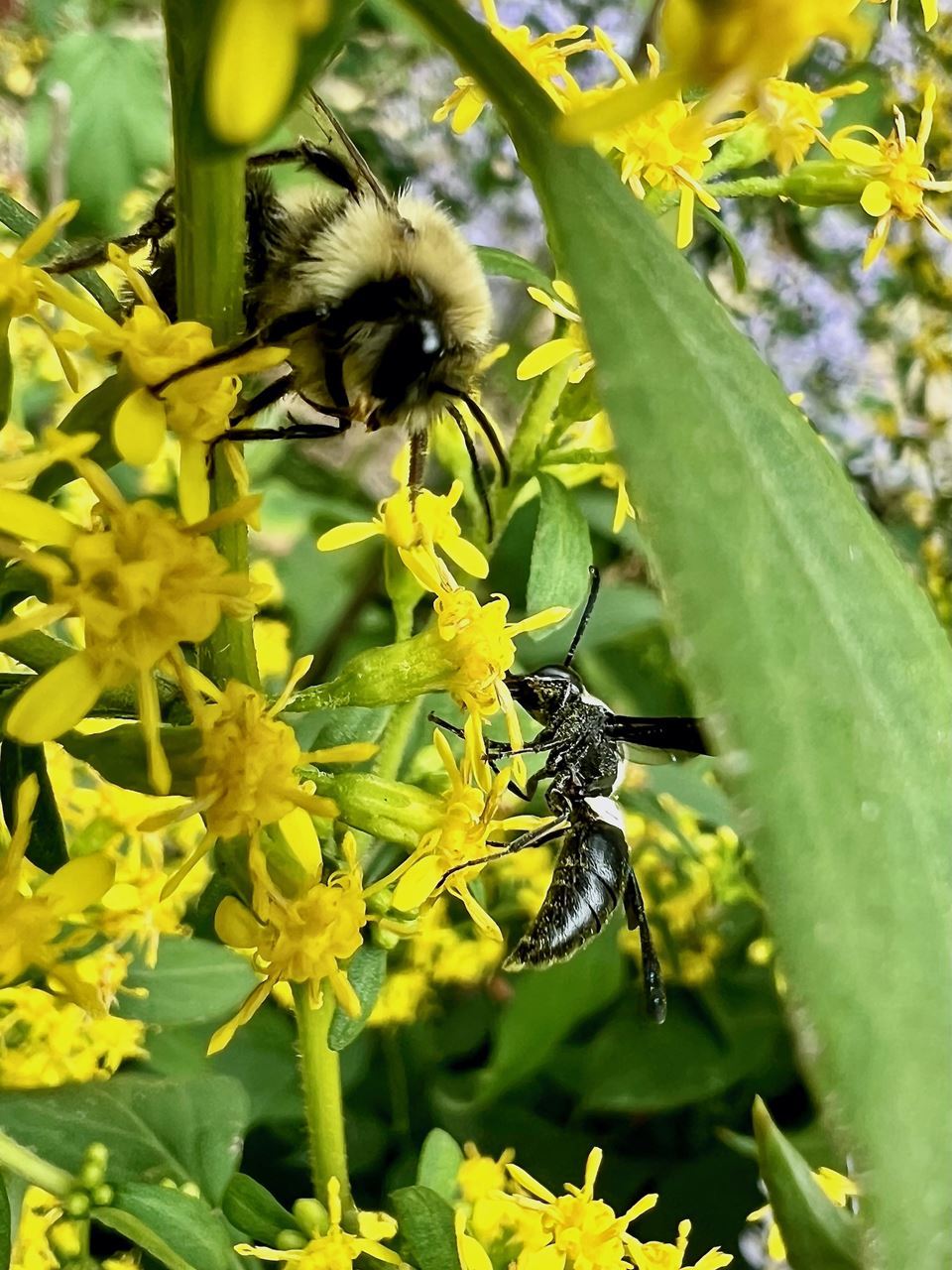
These deeply appreciated plants are quite drought resilient. In certain areas of our yard, where they actually seeded themselves, I thankfully observed, that they did not require additional watering. To note, these were locations receiving the softer east morning sunlight and shaded from the harsher west afternoon sun. These species find themselves right at home in our urban yard, as they do nearby, in Mississippi River area parks. They are signature plants in my perspective.
Late Spring/Summer Plantings: The Soft Landings was augmented with the following purchased plants: bottle brush grass, wild columbine, fox sedge, large leaved aster, large bellflower and notably a downy serviceberry, a small understory tree. The following species were transplanted: wild ginger, wild geranium, maiden hair fern, common blue violets, wild strawberry, Jacob’s ladder, and meadow rue. The Short’s aster planted, was a container winter-sowed species. All were checked on frequently and watered when needed, essential practice for the new arrivals. Again, all of these species are thriving in nearby natural areas and like our yard too. Through the thirty years of tending our yard, these are the ones that fare best. I’m going along with that. Not to say, new species don’t make their way into the mix.
This year we planted a mistflower, a native found in bordering states yet often introduced to native gar-dens here. This pretty plant appears to like it near our birdbath, therefore we’re considering planting more. What was an endearing clincher for us, was the observation of a common eastern bumble bee (Bombus impatiens) nectaring on the flowers (photo below). She appeared to be a gyne, an inseminated female who will overwinter and become next year's queen. I'm not 100% sure, but she is larger than other bumbles currently foraging and close to that time of year. Her fall job is to build up winter fat stores when there are the resources. All other bumbles that are not gynes will die as the weather cools. This is their last hurrah and our yard is giving them a nice send-off, among their comrades, with favorite last meals of aster and goldenrod. The population depends on the gynes and undisturbed nesting sites. 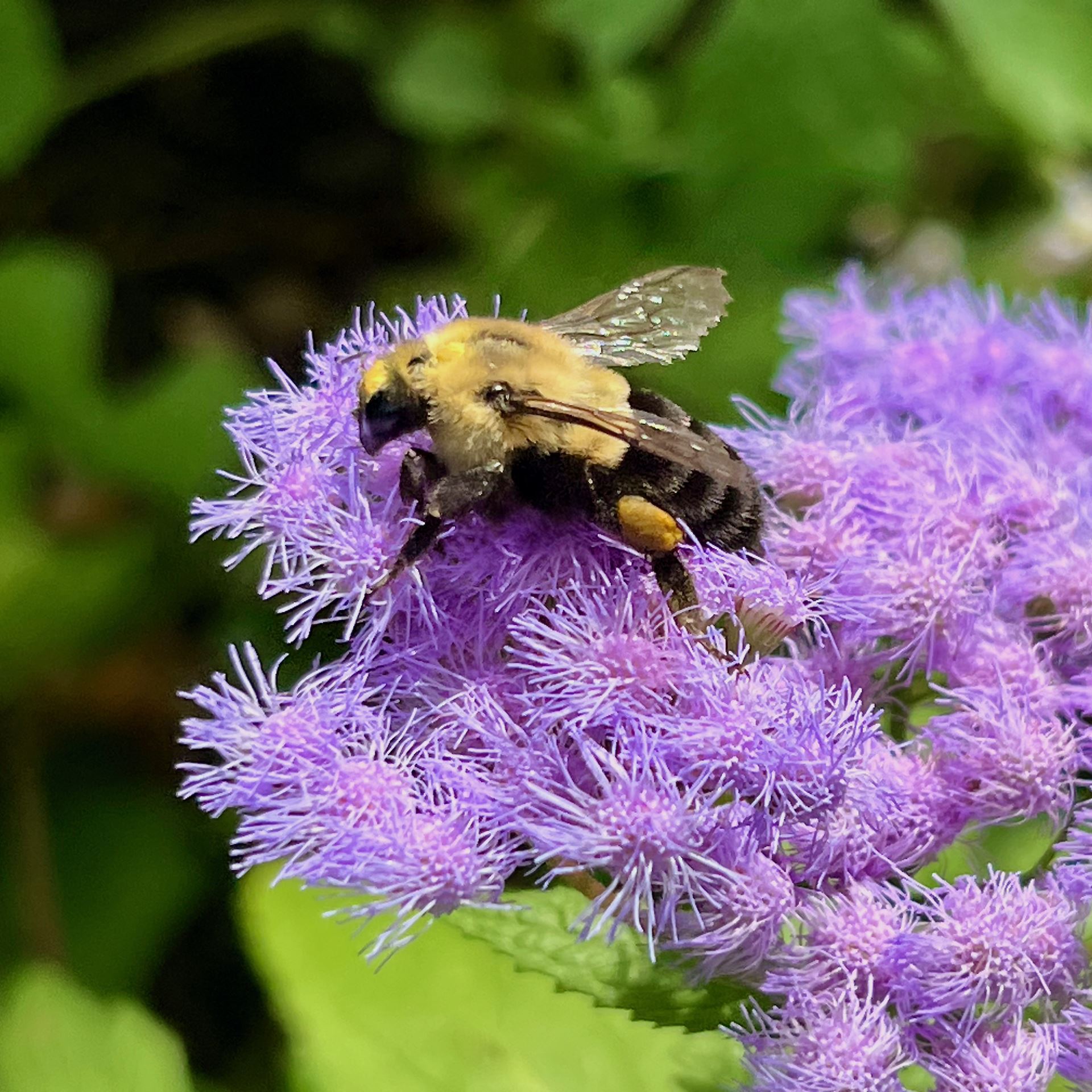
Fall Plantings: Often overlooked for planting, autumn is an optimal time to do so. Newly planted seedlings first develop their root system and this continues over the winter season. Plants have a healthy head start and can concentrate on the above ground growth in the coming spring. Another plus, after thorough watering (or rain) your work is done and nature takes over for the winter. This fall, I still plan to add more wild geranium, wild ginger, violets, Solomon’s seal and large-leaved aster - all divided from our yard. We have a beautiful lime-colored hosta, that I may divide as well. This non-native plays fair, doesn’t take over and could act as an orderly anchor in a garden corner. We have in our front rock garden and added to our neighbors yard would add to the organic feeling of flow we are striving for with the plants.
Over Winter: Our Soft Landings plantings are at their blooming best in the spring and fall. My assignment this winter is to research how to fill the summer gap. Our yard has been transitioning into less and less sun. There remains one large barren area that I’ve had yet to concede to this fact. This winter, the hope is to develop another plan of planting action. For your own winter planting plans, I invite you to check out Wild Ones Twin Cities resource page. There are many sources of inspiration, a personal favorite is the Prairie Moon catalog. I can mark up the pages with various colored highlighters to develop a plan that considers what I have and what would be complimentary.
Enjoy the fall colors cast in the most complimentary angle of sunlight.